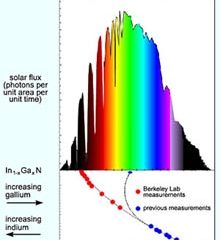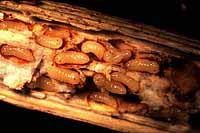
UCSF-led scientists have identified the first “master” molecule in the cell nucleus that controls the action of hundreds of different genes at once through its action on enzymes. The broad-acting molecule affects enzymes that restructure chromosomes, exposing genes to proteins that can then trigger key gene processes, including the start of protein production and copying and repairing of genes.
The molecule’s broad effect on a number of genes may allow organisms – including humans — to

Researchers in the Materials Sciences Division (MSD) of Lawrence Berkeley National Laboratory, working with crystal-growing teams at Cornell University and Japan’s Ritsumeikan University, have learned that the band gap of the semiconductor indium nitride is not 2 electron volts (2 eV) as previously thought, but instead is a much lower 0.7 eV.
The serendipitous discovery means that a single system of alloys incorporating indium, gallium, and nitrogen can convert virtually the full spectru

When they make their first public demonstration of tele-immersion at this week’s Super Computing 2002 conference in Baltimore, computer scientists will also attain another first: a “network computer” that processes data at a location far removed from either input or output.
While the tele-immersion system will gather and display information in side-by-side booths at the Baltimore Convention Center, actual data processing will occur some 250 miles away at the Pittsburgh Supercomputing C

Each spring, amid the decaying rubble of dead prairie plants, emerging male gall wasps find mates by calling upon the chemistry prowess of their predecessors, entomologists scouring Central Illinois have discovered.
In the Proceedings of the National Academy of Sciences, they report that as adult gall wasps (Antistrophus rufus) feed in warm weather, they change the ratio of plant chemicals so that males emerging after the winter season can recognize when they are on the right stems at the r

Two specific genes involved in cholesterol transport are required for the most common way excess cholesterol is expelled from our bodies, according to scientists at UT Southwestern Medical Center at Dallas.
The genes, the researchers report, are essential for efficient secretion of cholesterol into the bile, which is the major route that cholesterol exits the body. The discovery sheds new light on potential therapies that could play an important role in reducing high cholesterol, a ma

NSF awards grants to discover the relationships of 1.75 million species One of the most profound ideas to emerge in modern science is Charles Darwin’s concept that all of life, from the smallest microorganism to the largest vertebrate, is connected through genetic relatedness in a vast genealogy. This “Tree of Life” summarizes all we know about biological diversity and underpins much of modern biology, yet many of its branches remain poorly known and unresolved. To help

– new calculation confirms standard model of particle physics. Contribution of hadronic vacuum polarization determined with unprecedented accuracy. The magnetic moment of the muon is an important precision parameter for…
Technique may prevent formation of unwanted waves that siphon off needed energy. Heating plasma to the ultra-high temperatures needed for fusion reactions requires more than turning the dial on a…

An international team of astronomers, led by researchers from the Astronomical Observatory of the University of Warsaw, have identified a new class of cosmic X-ray sources. The findings have been…

How deubiquitinases USP53 and USP54 cleave long polyubiquitin chains and how the former is linked to liver disease in children. Deubiquitinases (DUBs) are enzymes used by cells to trim protein…

Conceptual blueprint to analyze experimental catalyst data. Machine learning (ML) models have recently become popular in the field of heterogeneous catalyst design. The inherent complexity of the interactions between catalyst…

Antibody that Neutralizes Inhibitory Factors Involved in Nerve Regeneration Leads to Enhanced Motor Function after Acute Spinal Cord Injury. Researchers at 13 clinics in Germany, Switzerland, the Czech Republic and…

How simulations help manufacturing of modern displays. Modern materials must be recyclable and sustainable. Consumer electronics is no exception, with organic light-emitting diodes (OLEDs) taking over modern televisions and portable…

“Neurons that fire together, wire together” describes the neural plasticity seen in human brains, but neurons grown in a dish don’t seem to follow these rules. Neurons that are cultured…

The quest for sustainable energy solutions has been a major focus of scientific research for decades. Solar energy, a clean and renewable source, has emerged as a promising alternative to…

With a processing speed a billion times faster than nature, chip-based laser neuron could help advance AI tasks such as pattern recognition and sequence prediction. Researchers have developed a laser-based…

New technology could remotely identify various types of plastics, offering a valuable tool for future monitoring and analysis of oceanic plastic pollution. Researchers have developed a new hyperspectral Raman imaging…

Artificial Intelligence (AI) has established a strong presence across industries, large and small. The “VoBaKI” research project has empowered small and medium-sized enterprises (SMEs) with an innovative tool to independently…